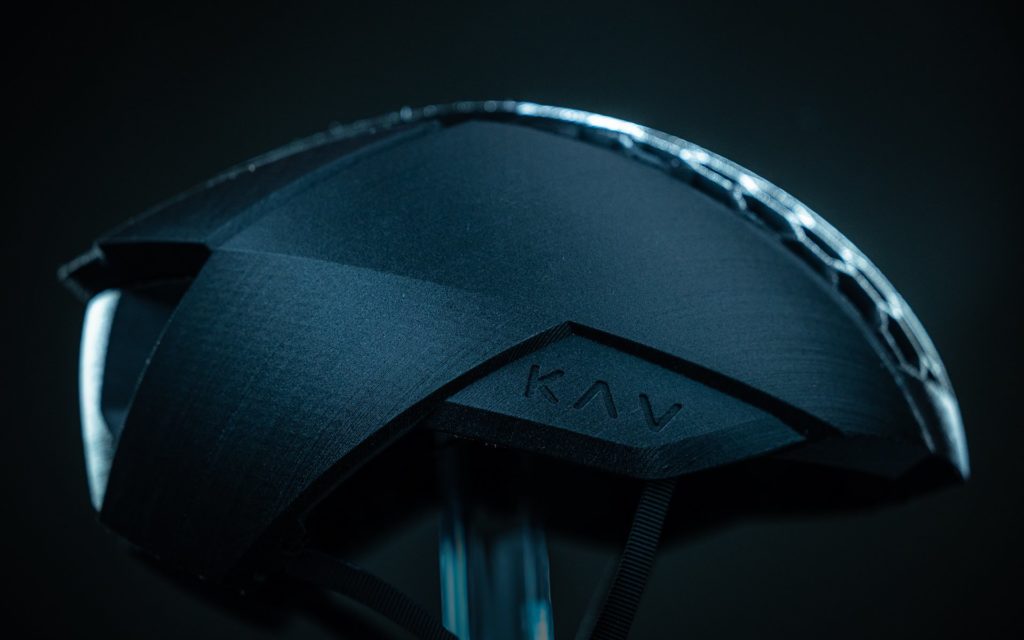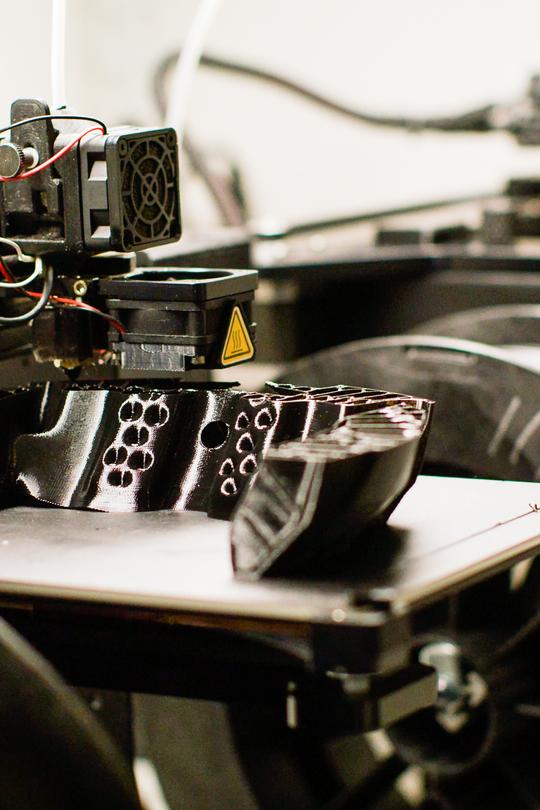One area where we’ve seen a lot of 3D printing activity is in helmets. Now, KAV is joining the fray with a mass-customized, made-to-measure helmet. The company says that machine learning is used to take the measurements that you input and turn them into a custom design. It is unclear why they would use machine learning to do this. The company touts a “patented energy management system”, that leads to a “slimmer helmet” with less drag and which weighs 300 grams. The helmet is also said to drive away heat eight times better than foam helmets.

“Despite a market where every aspect of the cycling from gearing to saddle position is tuned for maximum performance, cyclists have had to settle for a few sizes fits all mentality to protect the most important part of the body. The KAV Bike Helmet continues our tradition of creating a helmet that’s uncompromising in performance and protection, made possible by our made-to-measure fabrication technology. My KAV replaces and bests my previous aero helmet and my vented road helmet while the additional occipital coverage is perfect for providing extra protection for my gravel adventures,” KAV CEO Whitman Kwok says.
The company says that it can make the helmet in 7 billion sizes for children and adults. Additionally, KAV claims that their “hex based compression structure is up to 20% lighter than EPS foam and more efficient at absorbing impact energies. While foam is isotropic, 3D printing enables optimizing the energy management system to crumple and shear reducing rotational accelerations associated with concussions.”
I love the idea that they’ve essentially designed a crumple zone for humans that makes use of the anisotropic properties of 3D printed parts. This is an excellent example of taking a bug and turning it into a feature. I’ve long advocated for us to design crumple zones in all manner of objects for predictable, planned failure.
The KAV helmet—made from TPU and manufactured in Redwood City, U.S.—is now on Kickstarter and, at the time of writing, has gotten $15,000 in funding much more than the modest $8,000 goal. The helmet is a hefty $275 at the Kickstarter price, while the later cost is expected to be $375.

One interesting detail is that, rather than go for a newfangled 3D scan app, the company just asks you to measure your head. This indicates that there is a considerable opportunity in 3D scan-to-print apps that would cater to various companies that do not wish to spend time and money making their own apps. Another very exciting details is that the liners and helmets will be made using desktop 3D printers. I’ve been saying that desktop machines will be used for manufacturing for a while, but this is a comforting example of someone who wishes to make end-use parts on desktop machines. This would make the up-front investment and the cost per unit very low indeed!

KAV is not the only one in the 3D printed helmet game. You can now buy a customized 3D printed helmet from Kupol or Hexr. Several of the NFL helmet challenge participants also use 3D printing for their helmets. Why is additive such an interesting technology for helmets?
With 3D printing, we can make custom geometries to match your skull, giving you a better fit. What’s more, we can also make lightweight lattice or beehive structures that provide cushioning, but at a lower weight, and/or mass and/or with a thinner profile. At the same time, these helmets can be designed to do novel things. One could incorporate better airflow so your motion gives you some much needed air conditioning. They could be designed to wick sweat or optimally act like a heat sink. Perhaps the most interesting possibility is that helmets could be designed to absorb very different kinds of impacts. So, a heavy blunt force could be avoided, as well as a sharp fast crash, with the same design.

I think that helmets and other protective gear are an excellent opportunity for 3D printed goods. People will pay for safety. They will appreciate custom-fit items. The parts aren’t too large. We can also improve the cooling properties and impact properties of the device. There’s also a “look at me” factor when wearing such things that may also make them go viral in specific mountain biking communities, for example. I’m very excited at the prospect of 3D printing taking over the cycling market wholesale and really believe that protective equipment could be a huge industry for 3D printing going forward.
Subscribe to Our Email Newsletter
Stay up-to-date on all the latest news from the 3D printing industry and receive information and offers from third party vendors.
Print Services
Upload your 3D Models and get them printed quickly and efficiently.
You May Also Like
U.S. Navy Lab Uses 3D Printing to Reduce Tooling Lead Time By Over 90%
The F-35 Lightning II Joint Program Office (JPO), responsible for life-cycle management of the key fifth-generation joint strike fighter (JSF) system used by the U.S., its allies, and its partners,...
Etsy Design Rule Change Reduces Selection of 3D Printed Goods
Online marketplace Etsy has implemented a rule change requiring all 3D printed goods on the site to be original designs. The update to the site’s Creativity Standards states, ¨Items produced using...
Honeywell Qualifies 6K Additive’s Nickel 718 for 3D Printed Aerospace & Defense Parts
6K Additive is renowned for manufacturing sustainable additive manufacturing (AM) powder, and offers a wide portfolio of premium metal and alloy powders that include titanium, copper, stainless steel, and nickel,...
MetalWorm Sells WAAM Systems to Research Institutes in Brazil and Malaysia
Turkish WAAM firm MetalWorm has sold a system in Malaysia and another in Brazil. This is an excellent example of a few emerging trends in additive. Firstly, WAAM was experimented...

































